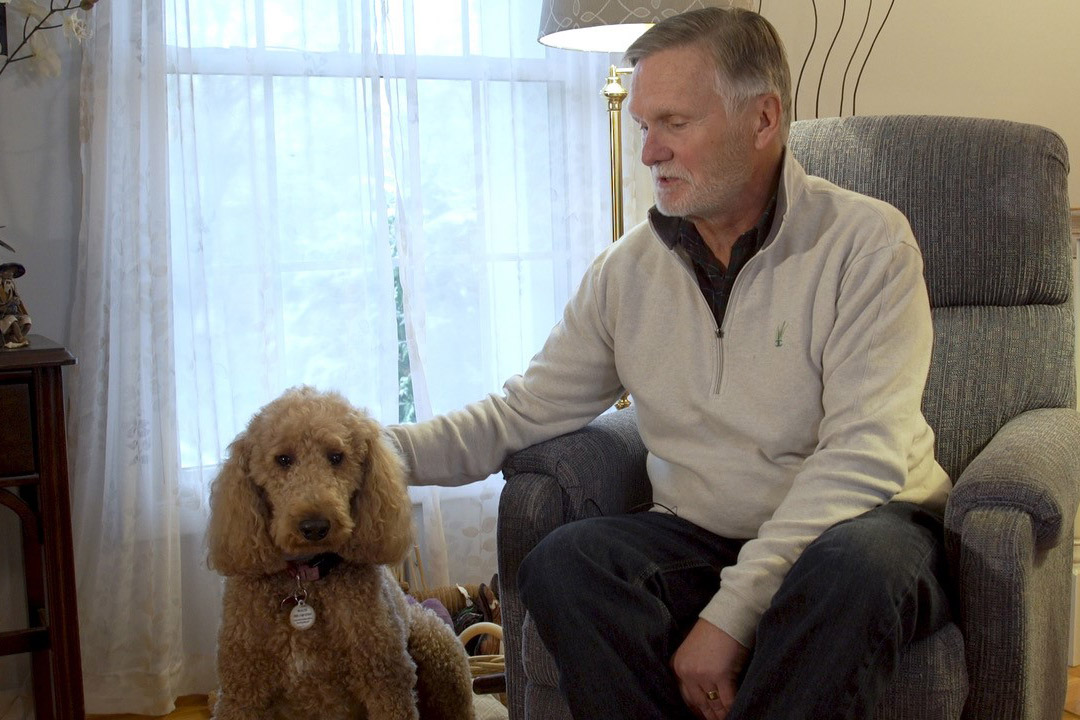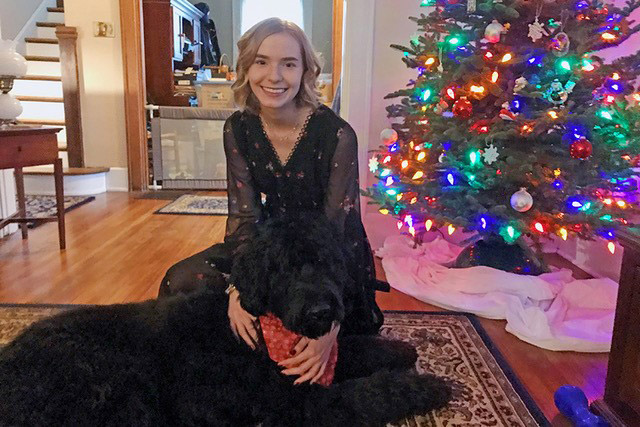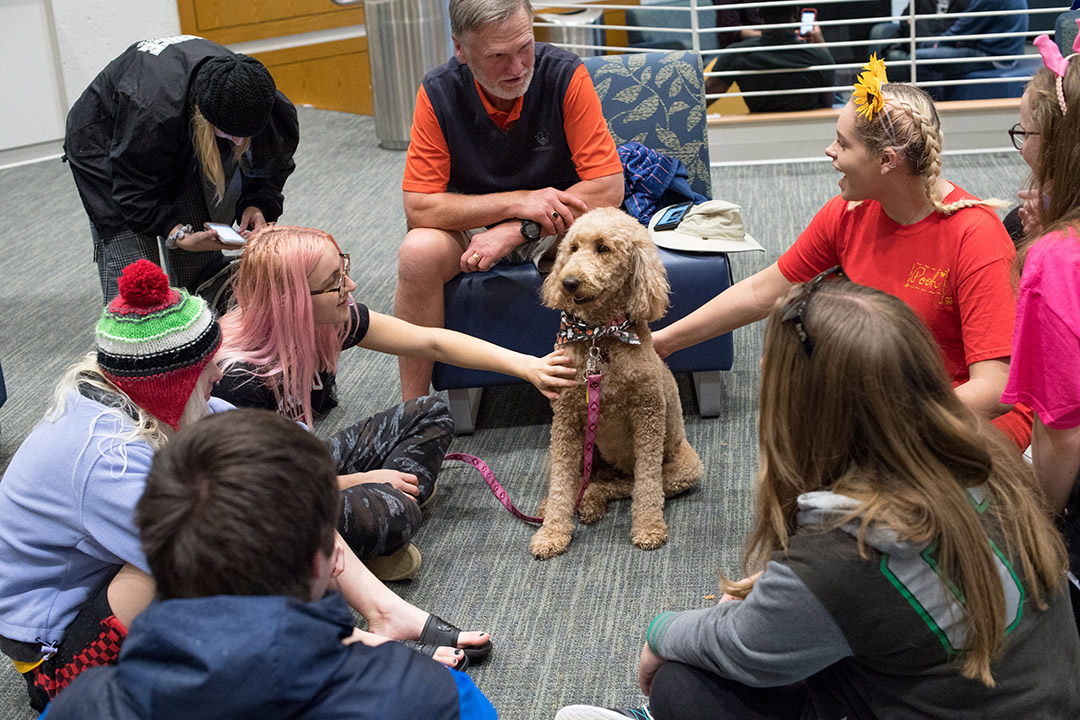Macie the therapy dog visits Wallace Library today; featured in student film ‘Mike & Macie’
A. Sue Weisler
Macie with RIT students in the Fireside Lounge earlier this fall. Wallace Library is hosting a therapy-dog event from 3 to 4:30 p.m. today on the first floor.
Ten minutes spent petting a dog can make a world of difference to a stressed-out college student—especially during finals week.
To help students relax, Wallace Library is hosting a therapy-dog event from 3 to 4:30 p.m. today on the first floor. The event is part of the library’s weeklong Destress Fest and a continuation of a monthly offering that many students enjoy. One student even made therapy dog Macie and her handler, RIT retiree Michael Servé ’71 (business administration), ’76 MBA, the subject of a documentary that will be shown this week in the MAGIC Center’s Wegmans Theater.
 Victoria Sebastian Michael Servé, an RIT alumnus and retiree, with his therapy dog Macie.
Victoria Sebastian Michael Servé, an RIT alumnus and retiree, with his therapy dog Macie.“The students get excited when they hear another event is coming up,” said Sara Kuehl, manager of marketing and communications at RIT Libraries. “I think therapy dogs are becoming more common on college campuses, particularly with academic libraries.”
A 2018 study in Stress and Health, by University of British Columbia researchers, investigated the impact of therapy dog sessions on college campuses and found a measurable short-term impact on student wellbeing. Participants reported reduction in stress and negative feelings.
“Wallace Library is open the most hours of any academic building on campus, and we see students spending long hours here,” Kuehl said. “Particularly as we get to finals week, you can feel the stress from the students. It’s palpable as you’re walking through the building. We created Destress Fest three years ago to help students relieve some stress without having to leave the library, encouraging them to take study breaks and practice some self-care.”
 RIT film production major Victoria Sebastian with her puppy Bear.
RIT film production major Victoria Sebastian with her puppy Bear.Victoria Sebastian, a third-year film and animation major from the Pittsburgh area, makes a priority of visiting therapy dogs at the library. She misses her German shepherd/poodle puppy Bear and likes the chance to “chill with a dog.” She’s not the only one.
Kuehl anticipates a crowd of students to form around the therapy dogs this afternoon. Typically, 200 to 300 students attend the monthly sessions with three dogs and their handlers, she said. Kuehl first invited handlers to bring their dogs to Wallace Library about three years ago and was amazed when nearly 400 students showed up eager to pet the three dogs.
“After we saw the overwhelming reaction—we decided this was something we should definitely continue,” Kuehl said. “We’ve been hosting therapy dogs monthly for the past year and a half, and there is always a good turnout.”
Kuehl reached out to Servé about bringing therapy dogs to Wallace Library. Servé, former assistant vice president for finance for NTID, retired from RIT in 2014 after 34 years of service. He has coordinated RIT-approved therapy-dog events on campus for nearly a decade. In 2011, he and his wife, Barbara Servé ’71 (retail), started bringing their late golden doodles, Toby and Tucker, to campus for NTID students. When word spread that Servé was organizing these events, he was asked to create the Bow Wow Wellness program for the university. (The next Bow Wow Wellness event will be held 4 to 5:30 p.m. Dec. 12 in the Student Alumni Union’s Fireside Lounge.)
Servé networks with the local group of volunteers affiliated with Therapy Dogs International to bring six to eight dog/handler teams to Bow Wow Wellness in the Fireside Lounge. The smaller space in the library is suitable for two to three dogs, he said, and his standard poodle Macie is a regular attendee.
“In an hour and half, the students just gravitate to the dogs. It’s a very satisfying thing,” Servé said. “The students want to talk about their dog at home that they miss so much. They want to know about Macie, they want to know how she was trained, and basically, they just want to hug the dog.”
The love is reciprocal.
“I think the work is good stimulus for the dog,” Servé said. “There is no sign of stress and she does it on back-to-back days and she’s fine. She’s been doing this work for so long; she knows what’s going on and is ready for it.”
Film student Sebastian had her own questions about what it takes to prepare a dog for pet therapy and made it the focus of a class project this fall for her documentary workshop.
“I wanted to focus on one person and their therapy dog to see all the work that they do and to thank them,” Sebastian said.
Kuehl connected her with Servé, and the project took shape.
Sebastian’s six-minute film, Mike & Macie, is a behind-the-scenes look at the life of a busy therapy dog and can be viewed on SOFAtube and on Sebastian’s YouTube channel.
“I learned there is a huge demand for therapy dogs,” Sebastian said. “Mike and Macie could do events every single day.”
Schools, colleges and hospitals are eager for therapy dog teams to visit, Servé said. He clarified that pet therapy dogs are not the same as service dogs for the blind or hard of hearing. “It’s a much lower bar that they pass.”
Nevertheless, Macie had to complete a six-week training course and pass a test to earn her certification through Therapy Dogs International. Macie had to demonstrate her ability to get along with multiple dogs, behave well in crowds and maintain her naturally calm disposition. She also had to prove her ability to resist food dropped on the floor. Macie’s training could save her life if the piece of food was actually medicine or another potentially dangerous object.
Sebastian and her cinematographer, Brandon Granby, a third-year film and animation major, interviewed Servé at his home. Macie was shy at first when she saw the foreign lighting equipment in her home, and Sebastian waited for her to warm up to the small crew and their gear.
“Victoria came to my house twice and filmed the dog in her home environment, proving that Macie may be a therapy dog, but No. 1 she’s a family dog, too,” Servé said. “And the dog performed. They filmed us getting the dog ready in the morning to go out on therapy-dog visits and the dog running in the back yard.”
Sebastian shadowed Servé and Macie at Wallace Library and at the Lois E. Bird/Morgan School in East Rochester, where twice weekly they visit children with special needs. Sebastian used the film to ask both sets of students what they think about having the dog come to their school.
“Macie is very calming, so they can take a break from what they’re doing, and laugh and smile for a while,” Sebastian said about the RIT students. “A lot of the younger kids said that it’s fun to have a dog, and when they walk in the room they know it’s going to be a good time.”
Producing the film has inspired Sebastian to explore therapy dog training in the future with her own puppy. For now, she will take advantage of the therapy-dogs on campus.
Servé and Macie will be back at Wallace Library from 3 to 4:30 p.m. Jan. 29 to provide comfort for students in need of dog time. Kuehl is happy the library can provide students a safe place to center themselves.
“Students leave smiling and you can almost see their shoulders relax,” Kuehl said. “It’s really great to see the positive impact therapy dogs have on the students.”
Victoria Sebastian’s tips for working with dogs
“You have to be ready for anything. It’s very spontaneous. You can’t predict what an animal is going to do. You can’t predict the reactions you’re going to get from students. It’s very on-your-feet to make sure you’re getting more than you need. The animal takes the lead. And you must get a lot of the shots that convey meaning visually. Because although with people they can explain things to you, but with dogs you have to show it instead.”





